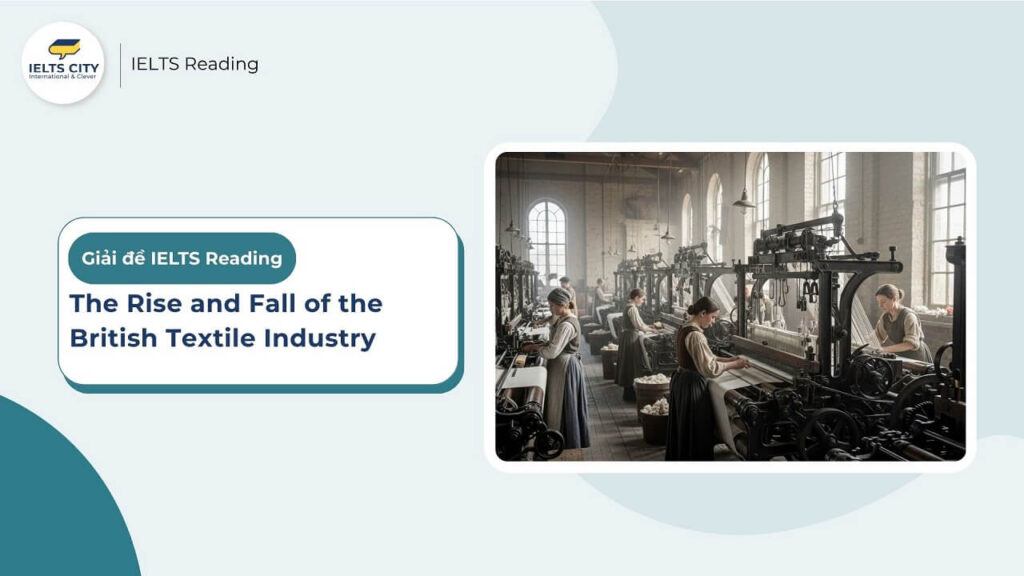
Nội dung chính
ToggleBài đọc
The Rise and Fall of the British Textile Industry
Textile production in Britain can be said to have its roots as an industry at the beginning of the 18th century, when Thomas Crotchet and George Sorocold established what is thought to be the first factory built in Britain. It was a textile mill with a waterwheel as its source of power, the latest machinery, and even accommodation for the workers. As well as possibly being the first sweatshop in the modern sense, it was the beginning of the end for traditional textile production.
For hundreds of years the spinning and weaving of cloth had been done manually by men, women and children in their own homes. The yarn would be combed and spun using a spindle, then woven on a hand loom, and what they produced would be mainly for local consumption. Technology far more sophisticated than the spindle and hand-loom would change all that.
The demand for cotton textiles had been growing since the Middle Ages, fostered by the importation of high quality cotton fabrics from the Middle East and India. So how were local producers to fight off the competition? The imported fabrics were of course expensive, so textile makers (not just in Britain but throughout Europe) produced mixed fabrics and cotton substitutes. They also had foreign textiles banned. But the key to the increased productivity needed to meet the demand, was machine production. It would be faster, cheaper and the finished products would be consistent in quality. Not least of the advantages was that it would allow manufacturers to market their goods on a large, if not yet global, scale.
The story of the growth of the British textile industry from about 1733 and for the next two hundred years is one of constant technological innovation and expansion. In 1733 John Kay invented the fly-shuttle, which made the hand-loom more efficient, and in 1764 James Hargreaves came up with the spinning jenny, which among other things had the effect of raising productivity eightfold. The next great innovator was Richard Arkwright, who in 1768 employed John Kay (of the fly-shuttle) to help him build more efficient machinery. He was a man with a vision – to mechanise textile production – and by 1782 he had a network of mills across Britain. As the water-powered machinery, though not yet fully mechanised, became more complex, Kay began to use steam engines for power. The first power-loom, however, which was invented in 1785 by Dr Edmund Cartwright, really did mechanise the weaving stage of textile manufacture.
The pace of growth quickened with the expansion of Britain’s influence in the world and the acquisition of colonies from which cheap raw materials could be imported. For example, in a single decade, from 1781 to 1791, imports of cotton into Britain quadrupled, going on to reach 100 million pounds in weight in 1815 and 263 million in 1830. The increase in exports is equally impressive; in 1751 £46,000 worth of cloth was exported and by the end of the century this had risen to £5.4 million. By the end of the 19th century the figure had soared to close on £50 million. Britain was now supplying cheaper and better quality clothing to a global market. Yet during the course of the 20th century Britain lost its position as a major textile manufacturer.
So what happened? There are a number of views on this question, not all of them conflicting, and where there is disagreement it is usually about when the decline began. Whether it began before the First World War (1914-18), or during the inter-war years (1919-1939), or after 1945, most economists would give roughly the same reasons. To start with, there was competition from abroad, especially from developing countries in the Far East, notably Japan. It was thought by manufacturers that the best way to combat this increased competition was to modernise. However, management and the labour unions were unable to agree on how to handle this situation.
Modernisation would mean people losing their jobs and possibly a change in labour practices. Such changes as were made served only to slow down the industry’s decline rather than help regain its predominant position. Economically less developed countries, on the other hand, had the advantage of being able to provide low wage competition, without the problem of powerful labour unions.
There are, of course, many other reasons for the textile industry’s decline, two of which became particularly noticeable in the late twentieth century and are related. The first is outsourcing, when manufacturers establish factories in countries where there is cheap labour. This obviously leads to less demand for locally-produced goods. Related to this, the textile and clothing industries have acquired a bad reputation for exploiting workers, often illegal immigrants, in sweatshops where they are forced to work long hours and are paid far less than the minimum wage.
We seem to be back with Crotchet and Sorocold and their first live-in factory. The globalising trend of out-sourcing, however, was a rational response to the growing competition from overseas, which, it goes without saying, does not excuse the exploitation of workers. The British industry itself, while no longer holding a key place in the global textile market has adapted itself and now concentrates more on the world of fashion and design, where it seems to be doing quite well.
Kiến thức cần nắm:
Câu hỏi
Questions 1-6
Complete the notes below. Write NO MORE THAN THREE WORDS for each answer.
Textile Manufacture
Early history
Begins as a cottage industry
Products hand-woven and made for 1 ……………
Local producers face 2 …………. from overseas
Ways found to deal with situation
Imported fabrics 3 ……………… , mixed cottons produced
Early technology
Machine production needed to 4 …………… for cotton fabrics
Improved technology (such as the fly-shuttle) more 5 ……….. and productive
Machinery begins to be powered by 6 ……………….
Kiến thức cần nắm:
Questions 7-9
Choose the correct letter, A, B, C or D.
7. Which of the following innovations increased productivity by 800%?
A. the power-loom
B. the steam engine
C. the spinning jenny
D. the fly-shuttle
8. During which period was the British textile industry at its peak?
A. 1733-1785
B. 1781-1791
C. 1791-1830
D. 1830-1900
9. Which of the following was a major cause of the British textile industry’s decline?
A. the expansion of foreign textile industries
B. the loss of overseas markets
C. there being no demand for products
D. labour becoming too expensive
Kiến thức cần nắm:
Questions 10-13
Do the following statements agree with the information given in Reading Passage? In boxes 10-13 on your answer sheet write:
TRUE if the statement agrees with the information
FALSE if the statement contradicts the information
NOT GIVEN if there is no information on this
10. Foreign textiles were banned because of their inferior quality.
11. Richard Arkwright built the first fully-mechanised textile mill.
12. In less developed countries, the industry could rely on cheap labour.
13. Out-sourcing was one method used to compete with foreign manufacturers.
Kiến thức cần nắm:
Đáp án kèm phân tích
Questions 1-6: Note completion
1. local consumption
- Giải thích: Câu hỏi nói về sản phẩm được làm ra cho ai. Đoạn 2 mô tả ngành công nghiệp tại gia (cottage industry), nói rằng “những gì họ sản xuất chủ yếu là để tiêu thụ tại địa phương” (local consumption).
- Vị trí và trích dẫn: Đoạn 2, câu 2.”…and what they produced would be mainly for local consumption.”
2. competition
- Giải thích: Câu hỏi nói rằng các nhà sản xuất địa phương phải đối mặt với “…” từ nước ngoài. Đoạn 3 mô tả việc nhập khẩu vải cotton chất lượng cao và đặt câu hỏi: “Vậy làm thế nào các nhà sản xuất địa phương chống chọi lại sự cạnh tranh?” (fight off the competition?).
- Vị trí và trích dẫn: Đoạn 3, câu 2.”So how were local producers to fight off the competition?”
3. banned
- Giải thích: Câu hỏi nói về cách giải quyết tình hình, một trong số đó là vải nhập khẩu bị “…” . Đoạn 3 liệt kê các chiến lược: “…họ cũng cho cấm vải nước ngoài” (had foreign textiles banned).
- Vị trí và trích dẫn: Đoạn 3, câu 3.”They also had foreign textiles banned.”
4. meet the demand
- Giải thích: Câu hỏi nói rằng sản xuất bằng máy móc là cần thiết để “…” đối với vải cotton. Đoạn 3 nói rằng chìa khóa để tăng năng suất cần thiết để “đáp ứng nhu cầu” (meet the demand) chính là sản xuất bằng máy móc.
- Vị trí và trích dẫn: Đoạn 3, câu 4.”But the key to the increased productivity needed to meet the demand, was machine production.”
5. efficient
- Giải thích: Câu hỏi nói công nghệ cải tiến (như fly-shuttle) thì “…” và năng suất hơn. Đoạn 4 nói rằng John Kay đã phát minh ra fly-shuttle, thứ “làm cho khung dệt tay trở nên hiệu quả hơn” (made the hand-loom more efficient).
- Vị trí và trích dẫn: Đoạn 4, câu 2.”…John Kay invented the fly-shuttle, which made the hand-loom more efficient…”
6. steam engines
- Giải thích: Câu hỏi nói rằng máy móc bắt đầu được cung cấp năng lượng bởi “…” . Đoạn 4 mô tả rằng khi máy móc chạy bằng nước trở nên phức tạp, người ta bắt đầu “sử dụng động cơ hơi nước” (use steam engines) để cung cấp năng lượng.
- Vị trí và trích dẫn: Đoạn 4, câu 4.”…Kay began to use steam engines for power.”
Đăng ký nhận tư vấn miễn phí
Ưu đãi học phí lên đến 40%
& Cơ hội nhận học bổng trị giá 2.000.000 VNĐ
Đăng ký nhận tư vấn miễn phí
Ưu đãi học phí lên đến 40%
________
Questions 7-9: Multiple Choice
7. Which of the following innovations increased productivity by 800%?
- Đáp án: C. the spinning jenny
- Giải thích: 800% tương đương với “gấp tám lần” (eightfold). Đoạn 4 nói rằng James Hargreaves đã phát minh ra “máy kéo sợi jenny” (spinning jenny), thứ “có tác dụng nâng năng suất lên gấp tám lần” (raising productivity eightfold).
- Vị trí và trích dẫn: Đoạn 4, câu 2.”…James Hargreaves came up with the spinning jenny, which among other things had the effect of raising productivity eightfold.”
8. During which period was the British textile industry at its peak?
- Đáp án: D. 1830-1900
- Giải thích: Đoạn 5 mô tả sự tăng trưởng mạnh mẽ của xuất khẩu, đạt đỉnh “vào cuối thế kỷ 19” (By the end of the 19th century) với con số 50 triệu bảng. Ngay sau đó, đoạn 6 nói rằng sự suy thoái xảy ra “trong suốt thế kỷ 20”. Vì vậy, thời kỳ đỉnh cao (peak) phải là giai đoạn cuối cùng của thế kỷ 19, tức là 1830-1900.
- Vị trí và trích dẫn: Đoạn 5, câu 3.”By the end of the 19th century the figure had soared to close on £50 million.”
9. Which of the following was a major cause of the British textile industry’s decline?
- Đáp án: A. the expansion of foreign textile industries
- Giải thích: Đoạn 6 hỏi nguyên nhân của sự suy thoái. Câu trả lời đầu tiên được đưa ra là: “Để bắt đầu, có sự cạnh tranh từ nước ngoài, đặc biệt là từ các nước đang phát triển ở Viễn Đông…” (there was competition from abroad…). “Sự bành trướng của các ngành dệt may nước ngoài” (the expansion of foreign textile industries) chính là “sự cạnh tranh từ nước ngoài”.
- Vị trí và trích dẫn: Đoạn 6, câu 3.”To start with, there was competition from abroad…”
Questions 10-13: TRUE / FALSE / NOT GIVEN
10. Foreign textiles were banned because of their inferior quality.
- Đáp án: FALSE
- Giải thích: Câu này nói vải nước ngoài bị cấm vì “chất lượng kém” (inferior quality). Tuy nhiên, Đoạn 3 lại nói rằng nhu cầu được thúc đẩy bởi việc nhập khẩu vải cotton “chất lượng cao” (high quality). Chúng bị cấm để bảo hộ sản xuất trong nước, chứ không phải vì chất lượng kém.
- Vị trí và trích dẫn: Đoạn 3, câu 1.”…fostered by the importation of high quality cotton fabrics from the Middle East and India.”
11. Richard Arkwright built the first fully-mechanised textile mill.
- Đáp án: FALSE
- Giải thích: Đoạn 4 nói về Arkwright và tầm nhìn của ông là “cơ giới hóa sản xuất dệt may”. Tuy nhiên, đoạn văn nói rõ rằng “máy móc chạy bằng nước, mặc dù chưa được cơ giới hóa hoàn toàn (not yet fully mechanised), đã trở nên phức tạp hơn…”.
- Vị trí và trích dẫn: Đoạn 4, câu 4.”As the water-powered machinery, though not yet fully mechanised, became more complex…”
12. In less developed countries, the industry could rely on cheap labour.
- Đáp án: TRUE
- Giải thích: Đoạn 7 nói rằng “Các nước kém phát triển về kinh tế” (Economically less developed countries) có lợi thế là có thể “cung cấp sự cạnh tranh về lương thấp” (provide low wage competition). “Lương thấp” (low wage) đồng nghĩa với “lao động rẻ” (cheap labour).
- Vị trí và trích dẫn: Đoạn 7, câu 3.”Economically less developed countries… had the advantage of being able to provide low wage competition…”
13. Out-sourcing was one method used to compete with foreign manufacturers.
- Đáp án: TRUE
- Giải thích: Đoạn 9 nói rằng xu hướng “thuê ngoài” (out-sourcing) là một “phản ứng hợp lý trước sự cạnh tranh ngày càng tăng từ nước ngoài” (rational response to the growing competition from overseas). “Phản ứng” với sự cạnh tranh chính là một cách thức để “cạnh tranh”.
- Vị trí và trích dẫn: Đoạn 9, câu 2.”The globalising trend of out-sourcing, however, was a rational response to the growing competition from overseas…”
Cập nhật đề thi thật sớm nhất tại:





















